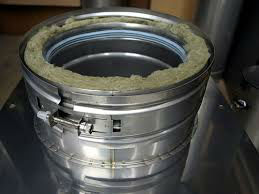What’s inside your chimney? If you’re like most homeowners, you assume that your chimney is a simple, hollow tube that allows smoke to escape up and out of your fireplace. While this is true to some extent, chimneys are more complicated than that. In fact, your chimney structure includes two basic components: the exterior shell of the chimney and an inner chimney liner.
What is a chimney liner? 
As the name suggests, the chimney liner lines the inside of your chimney. This is the hollow tube that you think of as the chimney “flue.” In a traditional masonry chimney, chimney liners are most often made of clay tiles that are able to deal with the extreme heat of your fireplace. With prefabricated fireplace system, or gas fireplaces, chimney liners are often stainless steel tubes inserted into the chimney structure. In some cases, traditional masonry chimneys have been relined with stainless steel or a poured cement specially designed for chimneys.
Why are chimney liners important?
Chimney liners actually do the brunt of the work of the chimney. They’re able to endure the heat from your fireplace, along with the occasional burning ember. They also contain the smoke and gases from your fireplace, preventing them from leaking into the rest of your home. Chimney liners also protect the chimney structure from the corrosive properties of gas and soot. Chimney liners are so sturdy, in fact, that they can contain low-grade chimney fires, potentially saving your home. Chimney liners are so important that building chimneys without liners has been referred to as “criminal.”
How do I know if my chimney liner is working?
Chimney liners can break down over time, and — very rare in modern chimneys — chimneys are occasionally lacking liners altogether. So how do you know if the all-important chimney liner is in place and in good repair above your fireplace? With a chimney inspection. During your annual chimney sweeping and inspection, your chimney sweep will inspect the interior of your chimney flue to make sure that your liner is in place and free from any damage that could compromise the security of the liner.
When do chimney liners need to be replaced?
There are a few occasions that call for chimney liner replacement. First, if your chimney sweep notices extreme damage, he or she might recommend chimney liner replacement. A change in the fuel type of your fireplace also might call for a new chimney liner that is designed for the fuel type. Finally, a new chimney liner is sometimes recommended if your chimney is drafting improperly; a correctly sized chimney liner can often resolve problems with chimney draft.
What are my options for chimney relining?
If you’re told you need a new chimney liner, you have a few primary options. Of course, a clay tile liner can be rebuilt, but that requires dismantling and rebuilding the entire chimney structure. To avoid this, a special poured cement can be used to smooth and recoat the clay tile liner to restore its function and strength. A stainless steel chimney liner also can be inserted down nearly any chimney. If you need a new chimney liner and you’re not sure what to choose, call Environmental Chimney Service! We can reline your chimney to keep your home safe.
